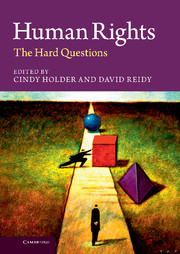Book contents
- Frontmatter
- Contents
- Figure
- List of table
- Notes on contributors
- Introduction
- Part I What are human rights?
- 1 Human rights and human nature
- 2 Universalism and particularism in human rights
- 3 Are human rights universal?
- Part II How do human rights relate to group rights and culture?
- Part III What do human rights require of the global economy?
- Part IV How do human rights relate to environmental policy?
- Part V Is there a human right to democracy?
- Part VI What are the limits of rights enforcement?
- Part VII Are human rights progressive?
- Index
- References
3 - Are human rights universal?
Published online by Cambridge University Press: 05 May 2013
- Frontmatter
- Contents
- Figure
- List of table
- Notes on contributors
- Introduction
- Part I What are human rights?
- 1 Human rights and human nature
- 2 Universalism and particularism in human rights
- 3 Are human rights universal?
- Part II How do human rights relate to group rights and culture?
- Part III What do human rights require of the global economy?
- Part IV How do human rights relate to environmental policy?
- Part V Is there a human right to democracy?
- Part VI What are the limits of rights enforcement?
- Part VII Are human rights progressive?
- Index
- References
Summary
Natural rights and human rights
Natural rights are the ancestor of contemporary human rights; and the idea of natural rights was a doctrine of universal rights, at least of those basic moral rights that were thought to hold good in a state of nature. The UN’s Universal Declaration of Human Rights (UDHR, 1948) is the keystone of contemporary human rights thinking, and it proceeds from the view that the human rights enunciated there have a foundation in morality and are universal.
By the last few decades of the nineteenth century, the notion of natural rights had lost or begun to lose its appeal (see Waldron 1987, for excerpts from some of the main critics). After World War II, universal rights made a return to center stage, first in the United Nations Charter (1945) and then in the UN’s Universal Declaration of Human Rights (UDHR, 1948) and the various covenants and treaties respecting human rights that came after that. But this return was not simply a revival of old-style natural rights. Indeed, many writers today (e.g., Beitz 2009; Boucher 2009; Darby 2009) stress that there is a considerable discontinuity between natural rights and what are today called human rights.
- Type
- Chapter
- Information
- Human RightsThe Hard Questions, pp. 59 - 76Publisher: Cambridge University PressPrint publication year: 2013
References
- 3
- Cited by

